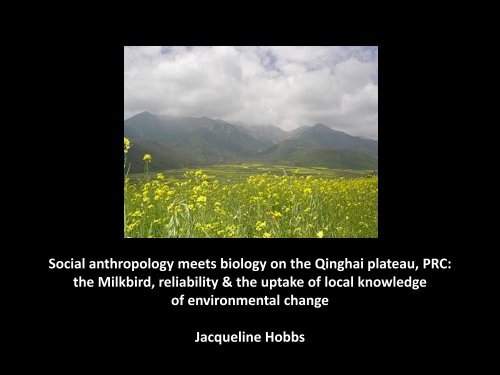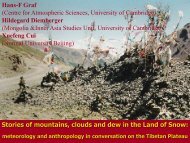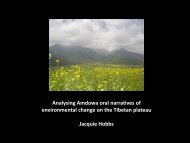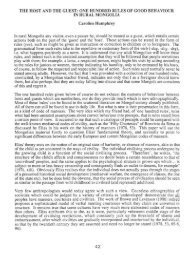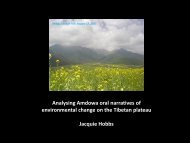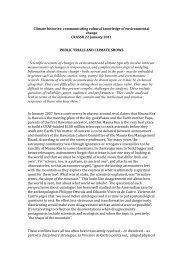Social anthropology meets biology on the ... - Climate Histories
Social anthropology meets biology on the ... - Climate Histories
Social anthropology meets biology on the ... - Climate Histories
Create successful ePaper yourself
Turn your PDF publications into a flip-book with our unique Google optimized e-Paper software.
<str<strong>on</strong>g>Social</str<strong>on</strong>g> <str<strong>on</strong>g>anthropology</str<strong>on</strong>g> <str<strong>on</strong>g>meets</str<strong>on</strong>g> <str<strong>on</strong>g>biology</str<strong>on</strong>g> <strong>on</strong> <strong>the</strong> Qinghai plateau, PRC:<br />
<strong>the</strong> Milkbird, reliability & <strong>the</strong> uptake of local knowledge<br />
of envir<strong>on</strong>mental change<br />
Jacqueline Hobbs
PhD <strong>the</strong>sis. “When <strong>the</strong><br />
Milkbird comes”: Amdo-<br />
Tibetan c<strong>on</strong>structi<strong>on</strong>s of time<br />
Nomads, Anye Machen area, May 28, 2008<br />
Abstract: “When <strong>the</strong> Milkbird comes, Amdo-Tibetan<br />
nomads in Qinghai province, PRC say <strong>the</strong>ir yak begin<br />
to give milk. These nomads frequently menti<strong>on</strong> <strong>the</strong><br />
Milkbird when <strong>the</strong>y are asked about time and its<br />
appearance is linked to <strong>the</strong> agricultural calendar.<br />
But this is <strong>on</strong>ly <strong>on</strong>e time-reck<strong>on</strong>ing system and<br />
<strong>the</strong>re are diverse Amdo-Tibetan c<strong>on</strong>structi<strong>on</strong>s of<br />
time to be found across today’s Amdo regi<strong>on</strong>. What<br />
is <strong>the</strong> nature of <strong>the</strong>se c<strong>on</strong>structi<strong>on</strong>s and how should<br />
we interpret <strong>the</strong> Milkbird in relati<strong>on</strong> to <strong>the</strong>m This<br />
<strong>the</strong>sis reveals in <strong>the</strong>ir use of time-reck<strong>on</strong>ing devices,<br />
not just Amdowa inter-dependence with nature but<br />
<strong>the</strong>ir reacti<strong>on</strong>s to <strong>the</strong> hegem<strong>on</strong>y of Tibetan<br />
Buddhism and to <strong>the</strong> political authority of both<br />
imperial and modern China, including <strong>the</strong>ir<br />
resp<strong>on</strong>se to urgent ec<strong>on</strong>omic pressures and<br />
envir<strong>on</strong>mental change. Tibetan time-reck<strong>on</strong>ing<br />
systems emerge as linked to <strong>the</strong> political – but <strong>on</strong>ly<br />
to <strong>the</strong> extent that <strong>the</strong>y are anchored in local<br />
knowledge. This <strong>the</strong>sis suggests a new role for social<br />
<str<strong>on</strong>g>anthropology</str<strong>on</strong>g> in light of a critical evaluati<strong>on</strong> of <strong>the</strong><br />
status of local knowledge of envir<strong>on</strong>mental change;<br />
partially challenges Gell's (1992) work <strong>on</strong> <strong>the</strong><br />
politics of time; and introduces a new reading of <strong>the</strong><br />
Tibetan calendar, based <strong>on</strong> <strong>the</strong> <str<strong>on</strong>g>anthropology</str<strong>on</strong>g> of<br />
Buddhism.”<br />
Amdo-Tibetan m<strong>on</strong>ks, nomads, farmers,<br />
urbanites, academics & students<br />
Jan 2007 - May 2009<br />
Qinghai (& Gansu) province, PRC
The “gap”:<br />
• Nomads say <strong>the</strong>y d<strong>on</strong>’t use <strong>the</strong><br />
calendar, m<strong>on</strong>ks say <strong>the</strong>y do<br />
• Tibetan calendar empirically<br />
inaccurate (Henning 2007)<br />
• Empirical observati<strong>on</strong> of nature vs<br />
Tibetan Buddhist calendrical<br />
traditi<strong>on</strong> using that observati<strong>on</strong><br />
Time is political (Gell 1992):<br />
• Preservati<strong>on</strong> of identity often at<br />
expense of need for accuracy<br />
• Tibet defines itself in relati<strong>on</strong> to<br />
India, M<strong>on</strong>golia & China<br />
But it’s also n<strong>on</strong>-political:<br />
• Used knowledge-system of <strong>the</strong><br />
Tibetan Buddhist 2 Truths to<br />
legitimate any new calendar<br />
Even more political!<br />
• Any new, more, accurate timereck<strong>on</strong>ing<br />
system assimilated<br />
• PLUS any challenge to Tibetan<br />
identity subsumed<br />
Amdo-Tibetan c<strong>on</strong>structi<strong>on</strong>s of time …<br />
Tibetan calendars, Tibetan Medical Hospital, Lhasa, March 2oo8<br />
Reacti<strong>on</strong> to <strong>the</strong> politico-religious<br />
1<br />
authority of Tibetan Buddhism
Imperial China:<br />
Amdo always closer to China than to<br />
Lhasa where <strong>the</strong> Tibetan calendar<br />
(bod rtsis) is formulated<br />
• Used <strong>the</strong> 18 th century CE Chinese<br />
(Jesuit) calendar (rgya rtsis)<br />
• This calendar is highly accurate<br />
Modern China:<br />
• But via Tibetan Buddhist 2 Truths<br />
make it Tibetan: <strong>the</strong> “Amdo calendar”<br />
• The Chinese calendar becomes <strong>the</strong><br />
Gregorian calendar or just <strong>the</strong> Chinese<br />
calendar’s lunar or divinatory aspect<br />
The “gap” underlies <strong>the</strong>se:<br />
• Tibetan calendar is “accurate”,<br />
“scientific”, “spiritual”, “white”<br />
• Chinese calendar is “inaccurate,<br />
“backward”, “superstitious”, “black”<br />
Counter-hegem<strong>on</strong>ic discourses:<br />
• Simultaneously c<strong>on</strong>tradict & assent<br />
(Ong 1997, Ga<strong>on</strong>gkar 2001)<br />
• Enact ethnic au<strong>the</strong>nticity & cultural<br />
Amdo-Tibetan c<strong>on</strong>structi<strong>on</strong>s of time …<br />
Lo gsar, G Sh<strong>on</strong>gwa, Feb 1, 2008<br />
Reacti<strong>on</strong> to <strong>the</strong> political authority of<br />
2<br />
superiority (White 1998)<br />
imperial and modern China
Mdzo rgan ra har nomad<br />
May 16, 2008<br />
«Because <strong>the</strong> land is changing, <strong>the</strong><br />
animals are changing. They are<br />
thinner, less str<strong>on</strong>g, <strong>the</strong>re is no<br />
comparis<strong>on</strong> between <strong>the</strong> animals<br />
before and now. Winter is very cold.<br />
This spring is l<strong>on</strong>ger and <strong>the</strong> animals<br />
are weaker because it is colder. The<br />
land is changing. The earth is<br />
becoming smaller. It’s shrinking. The<br />
number of yak hasn’t changed but<br />
<strong>the</strong>y say 20 years ago all <strong>the</strong> sheep<br />
and yaks would go into <strong>the</strong> valley …<br />
Now it’s narrower than before and<br />
<strong>the</strong> sheep and yak cannot enter. The<br />
land is drier. The river is<br />
disappearing. In <strong>the</strong> past according<br />
to <strong>the</strong> Chinese lunar calendar, in<br />
April <strong>the</strong>re’s lots of baby yak and<br />
milk. Now <strong>the</strong> baby yak cannot stand<br />
because <strong>the</strong>y are too weak and<br />
because of <strong>the</strong> milk from <strong>the</strong> grass.»<br />
Photo by Jas<strong>on</strong> Davis
«Winter is very l<strong>on</strong>g. Also spring.<br />
Summer is short. Spring is late. This<br />
m<strong>on</strong>th is supposed to be <strong>the</strong> first of<br />
summer but it’s still winter or<br />
spring. The summer is colder.<br />
Before, this seas<strong>on</strong> was for<br />
shearing <strong>the</strong> sheep but now it’s too<br />
cold. There’s a lot of snow, less rain.<br />
The temperature is much lower.<br />
When I was young, I never heard of<br />
<strong>the</strong>re being not enough grass for<br />
animals but now thousands of<br />
animals are dying from starvati<strong>on</strong>.<br />
Before, my fa<strong>the</strong>r and grandfa<strong>the</strong>r<br />
said that every time <strong>the</strong>y rode, <strong>the</strong><br />
grass came up to <strong>the</strong> belly of <strong>the</strong><br />
horse. Their legs were always wet<br />
and <strong>the</strong> children hid in <strong>the</strong> grass, it<br />
was so thick. Now after Liberati<strong>on</strong>,<br />
<strong>the</strong> grass is hardly over our shoes.»<br />
Photo by Jas<strong>on</strong> Davis<br />
Chu khol ka nomad<br />
May 17, 2008
Jas<strong>on</strong> Davis<br />
• Assistant Professor in Biology at Radford University, USA<br />
• BSc in Biology; PhD in Neuroscience & Animal Behavior<br />
• Funded by UC Davis , NSF & Chinese Academy of Science:<br />
To map <strong>the</strong> impact of human envir<strong>on</strong>mental<br />
disturbance <strong>on</strong> stress and reproductive neuroendocrinology,<br />
immunocompetence and behavior patterns in s<strong>on</strong>gbirds<br />
<strong>on</strong> <strong>the</strong> Tibetan plateau<br />
“I have explored variati<strong>on</strong> in glucocorticoid receptor<br />
distributi<strong>on</strong> in relati<strong>on</strong> to stress in expanding<br />
populati<strong>on</strong>s of s<strong>on</strong>gbirds in <strong>the</strong> Pacific Northwest,<br />
sex differences in cognitive abilities in s<strong>on</strong>g birds, and<br />
species variati<strong>on</strong> in natural fear and stress resp<strong>on</strong>ses<br />
in primates. In my lab we use a wide range of<br />
techniques to study and experimentally manipulate<br />
neurophysiology. We also spend a lot of time in <strong>the</strong><br />
field catching birds in big nets”.<br />
Snow finches
Case study 1: The Milkbird (A: jo-byebu)<br />
«According to <strong>the</strong> lunar calendar it comes <strong>on</strong> May 1 st . It comes <strong>on</strong>ce <strong>the</strong>n goes away<br />
in mid July. The milk, <strong>the</strong> Milkbird brings milk. The nomads like <strong>the</strong> Milkbird. Our<br />
forefa<strong>the</strong>rs told us that this is <strong>the</strong> bird which brings milk to <strong>the</strong> nomad, that’s why<br />
we believe in it.»<br />
[Amdo-Tibetan nomads say:]<br />
The reliability of local knowledge:<br />
“is it true”<br />
• It’s blue and white <strong>on</strong> <strong>the</strong><br />
upper chest. It has a l<strong>on</strong>g tail.<br />
• The Milkbird is blue, with<br />
thin white colour.<br />
• The Milkbird is black and<br />
white, with a white head.<br />
• It’s small, blue and white.<br />
• The Milkbird is blue with<br />
white colour.<br />
• It has white shoulders.<br />
• It has a white head.<br />
Siberian blue robin<br />
Oriental magpie robin<br />
Slaty-blue flycatcher<br />
Grandala
“L<strong>on</strong>g ago, grasslands and thick forests<br />
abounded in what is now Xichang City.<br />
Livestock and wild animals lived toge<strong>the</strong>r<br />
peacefully. The melodious sound of<br />
birds<strong>on</strong>g filled <strong>the</strong> air. In na mzi, that<br />
place was called O ndzo: a word people<br />
cannot explain today, o<strong>the</strong>r than to say it<br />
is <strong>the</strong> name of that place. One day a bird<br />
appeared and started calling "a za do bi!"<br />
The bird c<strong>on</strong>tinued to call this day after<br />
day. The na mzi were very embarrassed<br />
to hear this sound. Finally, <strong>the</strong>y all<br />
decided to leave this hateful bird and<br />
find a new place to live …”<br />
[Na mzi origin myth, Sichuan province, PRC]<br />
The reliability of scientific data:<br />
“Why do <strong>the</strong>y say <strong>the</strong>y never<br />
see this bird”<br />
Case study 2: “Bad luck” and<br />
“grandmo<strong>the</strong>r’s buttocks”<br />
Comm<strong>on</strong> Crow<br />
Little Owl
“You’ve been really useful, like …<br />
Uptake of cultural knowledge:<br />
so helpful, though I still can’t<br />
(reliable) quantitative -> qualitative -><br />
really see what place social<br />
… what happened<br />
<str<strong>on</strong>g>anthropology</str<strong>on</strong>g> has, in science … ”<br />
Winter<br />
Tree sparrow<br />
Misunderstandings & limitati<strong>on</strong>s<br />
• Meaning of c<strong>on</strong>cepts, comm<strong>on</strong> language<br />
• Sheer complexity of disciplines & human activity<br />
• Historicality/producti<strong>on</strong> of knowledge<br />
• Time factor, decisi<strong>on</strong>-making process<br />
• Status of cultural knowledge, even if reliable<br />
Collaborative outcomes<br />
• More accurate meteorological & species data<br />
• Time-depth: up to between 50 & 100 years<br />
• Cultural interpretati<strong>on</strong> & age factor -> more specific<br />
• Milkbird -> birds, time & empirical knowledge<br />
• Amdowas as producers of climate change models<br />
• Link between politics of time & politicisati<strong>on</strong> of local<br />
knowledge of envir<strong>on</strong>mental change
More successful collaborati<strong>on</strong> …<br />
Different understanding of communicati<strong>on</strong><br />
• Marilyn Stra<strong>the</strong>rn 2006<br />
• “Transplanted knowledge” = new generativity<br />
• Use of analogies: c<strong>on</strong>serve & extend<br />
• Discipline & its effects<br />
• Not a reducti<strong>on</strong>ist exercise<br />
• Incommensurability = strength!<br />
More embedded in university training<br />
• Transdisciplinary research projects from<br />
Bachelor’s level<br />
• Funding bodies with <strong>the</strong> ability to assess<br />
& prioritise such projects<br />
Resettlement “villages”<br />
Pallas’ Fish Eagle<br />
“Despite <strong>the</strong> extraordinary urgency of transdisciplinary<br />
climate research - by which I mean thinking that<br />
transcends <strong>the</strong> c<strong>on</strong>venti<strong>on</strong>al boundaries around disciplines -<br />
<strong>the</strong> modern university has largely failed to rise to <strong>the</strong> challenge”.<br />
[Wainwright 2010]


